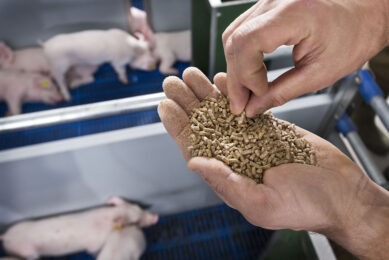More feeding during early gestation is feasible
The Dutch Product Board for Livestock, Meat and Eggs, De Heus Voeders and Varkens KI Netherlands commissioned Wageningen University to study certain feeding measures during early gestation of young sows.
The researchers examined if feeding 30% extra feed (3.25 kg v.s. 2.5 kg) or feeding a feed with 30% extra protein during the first four week of gestation, day 2-32 after insemination, influenced reproduction results and weight, back fat and muscle development. In addition, this study examined if weaning at three weeks positively influenced reproduction results in subsequent parity.
Experimental design
After insemination, 146 1st and 51 2nd parity sows were allocated to one of four treatments. Sows in the 4th treatment group were allocated to this group at farrowing. The four treatment group that were compared in this study were:
1. Control group: Sows in the Control group were fed 2.5 kg of a standard gestational feed during the first four weeks of gestation.
2. Plus Feed group: Sows in the Plus Feed group were fed 3.25 kg of a standard gestational feed during the first four weeks of gestation.
3. Plus Protein group: Sows in the Plus Protein group were fed 2.5 kg of a gestational feed containing 30% extra protein during the first four weeks of gestation.
4. Three Weeks group: Sows in the Three Weeks group were weaned at three weeks and were fed 2.5 kg of a standard gestational feed during the first four weeks of gestation.
During lactation sows were housed in farrowing crates, during the weaning to insemination interval and the first four weeks of gestation in individual crates and the remaining gestation in groups.
Main results and conclusions
The Plus Feed group gave significantly larger litters from 1st insemination (15.1 piglets) compared with the Control group (13.1 piglets). The Plus Feed group seemed to give more repeat breeders from 1st insemination (23%) compared with the Control group (10% repeat breeders), however this difference was not significant and can still be due to coincidence. Litter size and percentage of repeat breeders from 1st insemination of the Plus Protein (13.7 piglets and 10% repeat breeders) and Three Weeks group (13.3 piglets, 8% repeat breeders) were not significantly different from the Control group. The Plus Feed group shows a lower percentage of litters with ten or less piglets and a higher percentage of litters with 17 or more piglets from 1st insemination compared with the Control group.
Average piglet birth weight and piglets lost in the first three days after farrowing was not different between treatments. Sows in the Plus Feed group gained significantly more compared with other treatment groups (24 vs. 16 kg). The extra feed cost for the Plus Feed group was € 4.29 per sow per four weeks. The extra feed costs for the Plus Protein group was € 0.94 per sow per four weeks. The financial revenue of the increased litter size in the Plus Feed group compared with the Control group, taking the extra cost for the repeat breeders into account, is €66.88 on a yearly basis. However, we did not account for extra cost of a possible higher culling rate because of a higher number of repeat breeders.
Contradicting results
Feeding 30% extra protein during the first four weeks of gestation or weaning at three weeks showed no effects on reproduction in subsequent parity. Feeding 30% extra feed during the first 28 days of gestation, however, showed contradicting results. Litter size from 1st insemination was positively influenced without decreasing piglet birth weight, whilst the percentage of repeat breeders was increased. Perhaps the percentage of repeat breeders can be lowered by starting the high feeding level later after insemination. Literature shows, that a high feeding level starting right after insemination decreased embryonic survival in gilts. Placental development might be improved by the high feeding level level, causing piglet birth weight not to decrease, despite the higher litter size in the Plus Feed group.
More feed is financially feasible
Despite the higher percentage of repeat breeders, feeding extra feed during the first four weeks of gestation is financially feasible. If the percentage of repeat breeder can be lowered by finding an explanation for the higher percentage of repeat breeders, the feeding strategy will be even more feasible.
Join 18,000+ subscribers
Subscribe to our newsletter to stay updated about all the need-to-know content in the pigsector, three times a week. Beheer
Beheer










 WP Admin
WP Admin  Bewerk bericht
Bewerk bericht